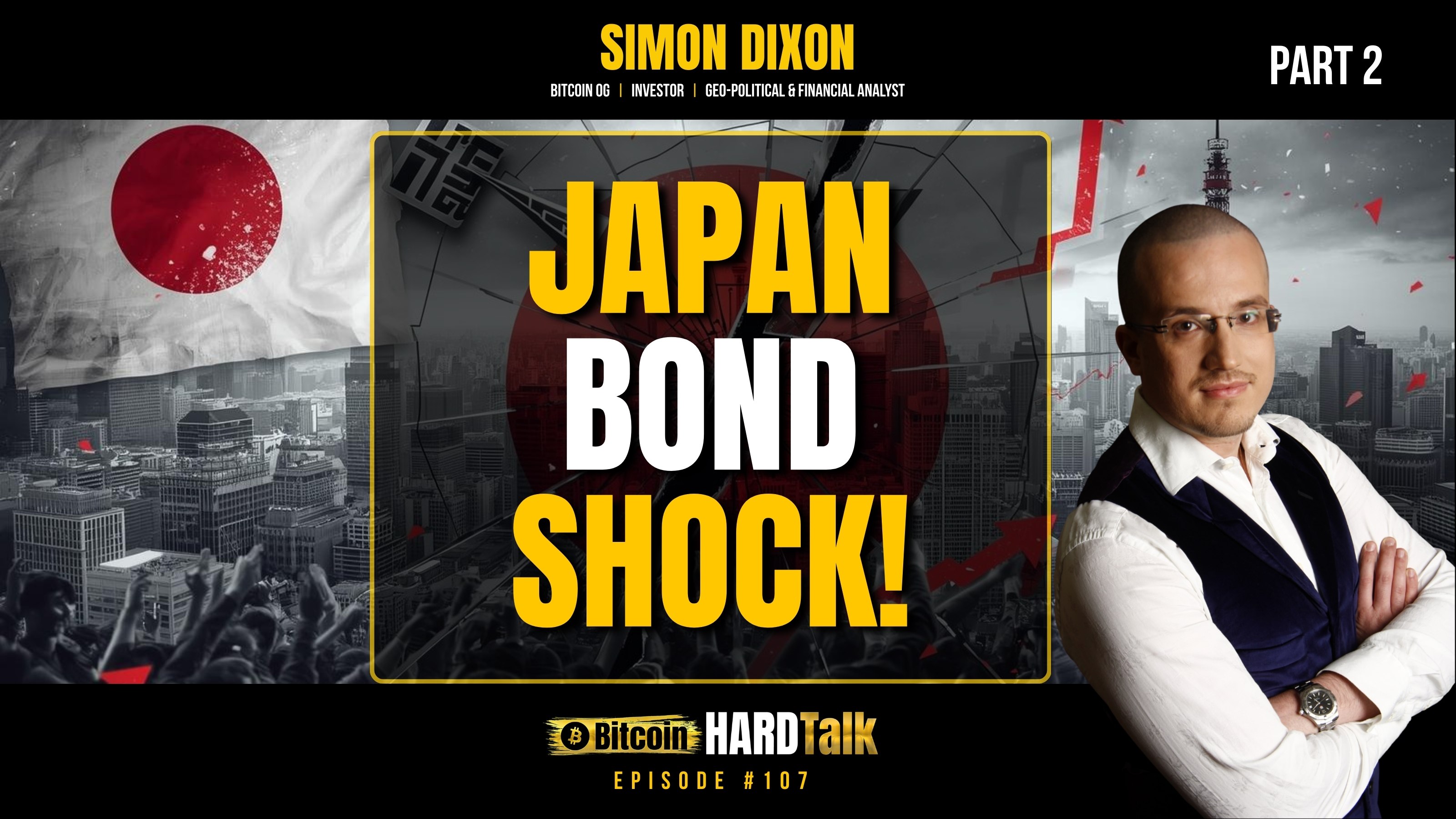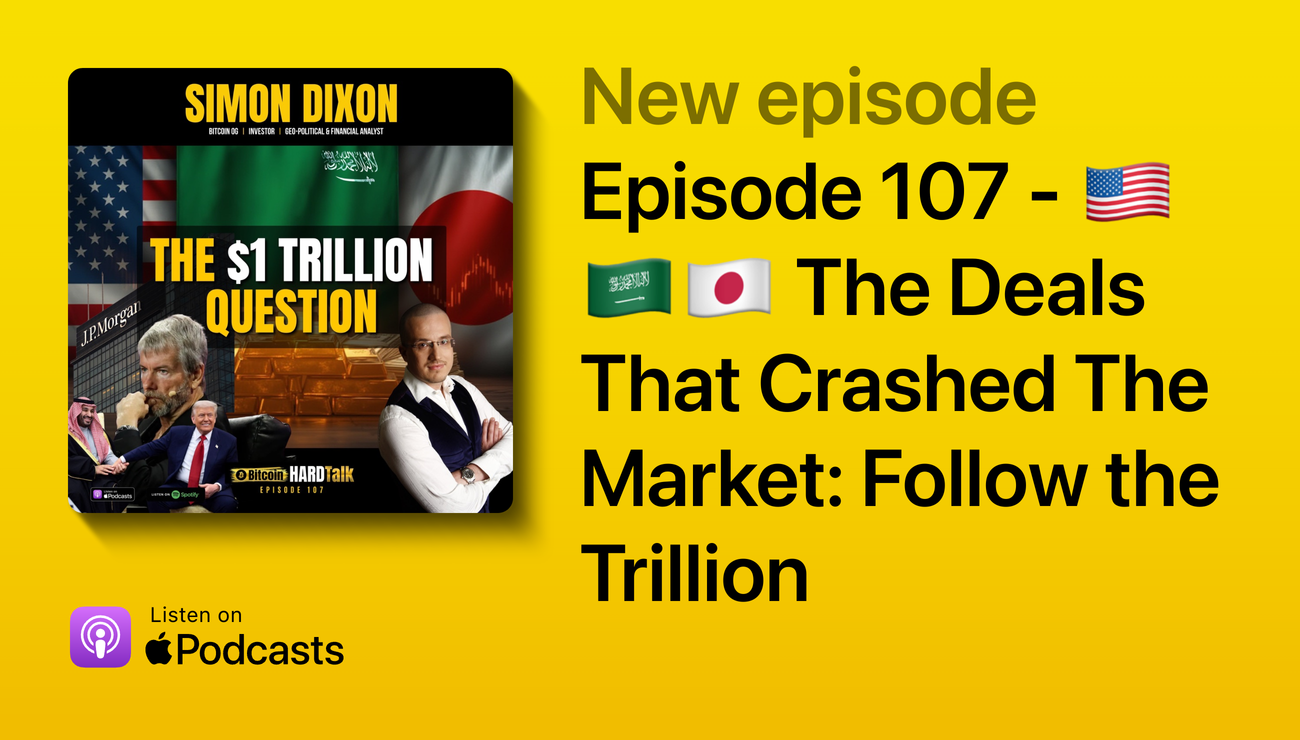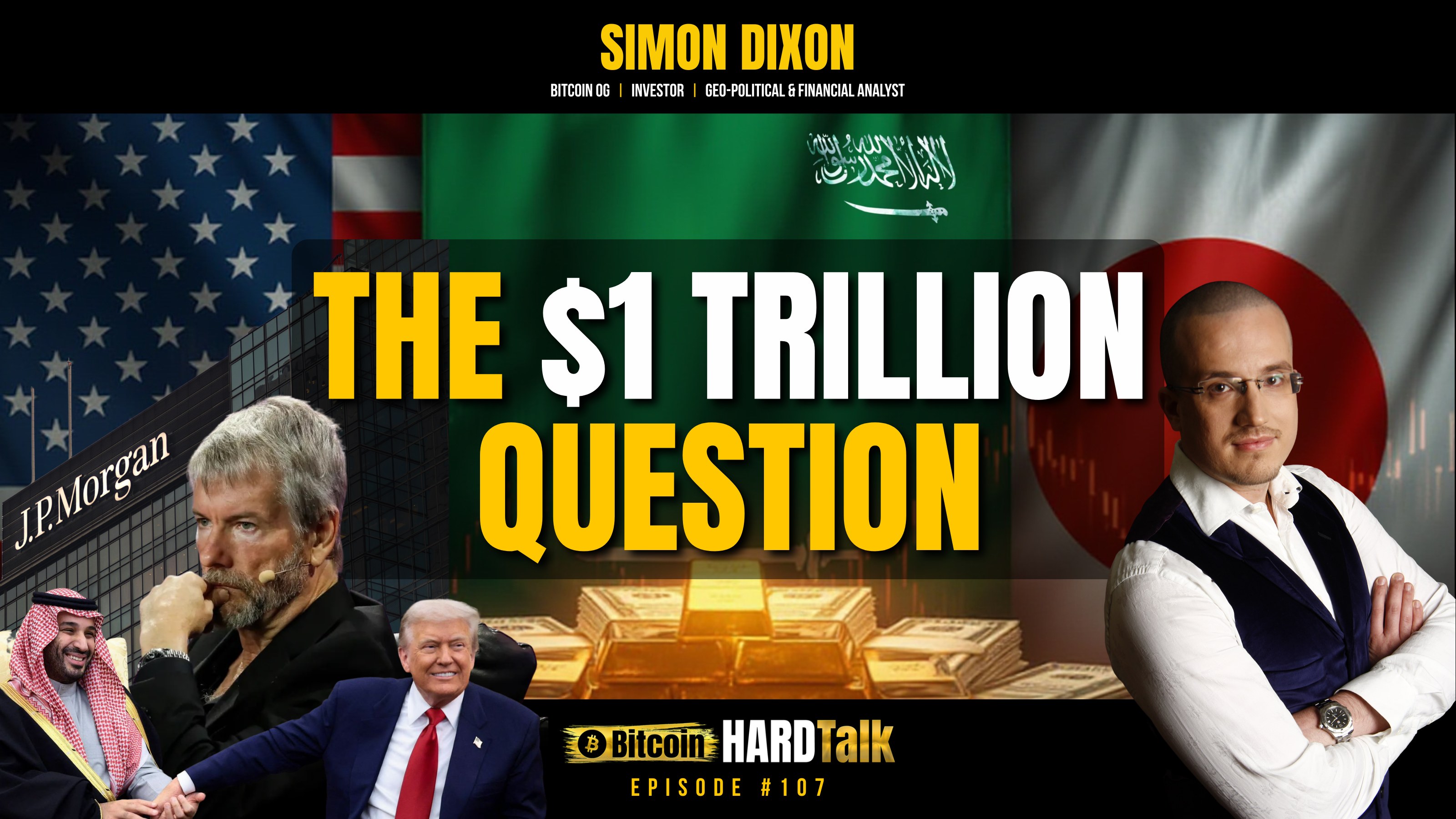Did J.P. Morgan & Saylor Just Crash Bitcoin? | This Week In Bitcoin | #BitcoinHardTalk Ep.107 (Part 1)
Nov 21, 2025Hey hey Bitcoin Wealth Builders,
The recent drop in Bitcoin and stock prices has sent a wave of speculation through the market. While mainstream headlines search for a simple cause, the reality is far more complex. This wasn't a random market fluctuation; it was a calculated series of events orchestrated by the "financial industrial complex" in my opinion—a network that sits atop the technical, military, and media industrial complexes, using them all as tools.
This system uses public companies, media narratives, and complex financial instruments as weapons to manipulate markets, consolidate power, and separate you from your assets. The players may change, but the game remains the same.
This post breaks down the key events from "This Week in Bitcoin," which is Part 1 of the full BitcoinHardTalk Episode 107. We will unpack how major institutions maybe pulling the strings and what you can do to protect yourself.
Watch Part 1 above, and then read on as we unpack the most critical takeaways.
1. J.P. Morgan Uses MicroStrategy as a "Financial Weapon"
The continuation of this week's downturn began with a strategic "warning" from J.P. Morgan analysts. They publicly speculated that Michael Saylor's MicroStrategy could be excluded from key market indices, including the MSCI USA and the Nasdaq 100. This isn't just about market indices; it's a public demonstration of the network's power to control any CEO who enters their system through public markets and debt.
This is a significant threat because it hinges on reclassifying MicroStrategy from a standard "operating company" to an "investment company" under the 1940 Investment Company Act. If this happens, the massive passive index funds that track these benchmarks would be legally forced to sell their MicroStrategy shares. This would trigger enormous outflows, as these funds have nearly $9 billion in market exposure to the company.
This move is a classic example of the "proof of weapons network" in action. As I explain, once a CEO takes their company public and takes on debt, they become a tool that can be leveraged by the financial industrial complex.
...anybody that joins and goes public or goes through the private equity phase into the Silicon Valley phase into the public market phase becomes subordinate to the proof of weapons network...
2. The Bitcoin Treasury Company Trap Is Sprung
The market downturn exposed a systemic flaw in the Bitcoin treasury company model. Unlike Bitcoin itself, these public companies have significant real-world operational costs: salaries, lawyers, accountants, directors, and professional fees.
A prime example is Nakamoto, which recently announced it was forced to sell 367 Bitcoin to cover $35 million in costs. When the price of Bitcoin falls, these companies, which often have little to no revenue, must sell their primary asset—Bitcoin—to stay afloat.
This creates a vicious downward spiral. A company sells Bitcoin to cover costs, which pushes the market price down further. This can trigger margin calls for leveraged investors and force other treasury companies to sell their holdings, accelerating the crash. It is a self-reinforcing cycle designed to shake out weak hands.
This highlights the core lesson I have taught for years:
...bitcoin in self-custody has no salary and no overhead and no lawyer and no professional and no operation to pay that's why we do Bitcoin in self-custody rather than these treasury companies.
3. While Retail Fears, Institutions Accumulate
While leveraged traders and Bitcoin treasury companies were being forced to sell, the architects of the system were buying. This is not a separate event, but the second half of a single, cohesive maneuver. Step one is to weaponize a public company like MicroStrategy to create fear and trigger a sell-off. Step two is for the network's prime nodes to acquire the assets shed by weaker hands at a discount.
In a telling move, the Harvard University endowment fund took the opportunity during the dip to triple their holdings in the Bitcoin ETF. They can utilize the orchestrated fear, media narratives, and financial weapons to trigger a sell-off, then step in to accumulate more assets at a lower price from those who are forced out of their positions. They create the panic, then profit from it.
4. A Sovereign Nation Pushes Back
Amid the institutional power plays, the nation of El Salvador made a clear statement. On top of its "one Bitcoin a day" accumulation program, the country bought an additional 1,000 Bitcoin.
This is a strategic move for a nation attempting to build a sovereign treasury free from the control of institutions like the International Monetary Fund (IMF). By holding Bitcoin in self-custody, El Salvador gains leverage in geopolitical negotiations.
However, as I fear, El Salvador may still be "vasilized" by the IMF, as it needs to accumulate significantly more Bitcoin to become fully insulated. This strategy is not just about financial pressure from the IMF; it's a potential shield against the increasing geopolitical pressure America is likely to exert on its neighbors as its global influence wanes and it can no longer conduct covert operations as freely in Asia and the Middle East.
Your Antidote: The Simple, Unshakeable Strategy
For the individual investor, navigating this complex and often predatory environment does not require complex trading strategies. The antidote is a simple, disciplined approach focused on removing yourself from the system's weapons.
- Own More Bitcoin: The primary goal is simple and unwavering: "own more Bitcoin this month than the previous month." Focus on accumulation, not short-term price action.
- Self-Custody Is Non-Negotiable: Holding your own keys is the ultimate defense. It removes you from the "financial weapons of mass destruction"—leverage, counterparty risk, and forced liquidations. If you don't hold the keys, you don't own the Bitcoin. Read the self-custody blog
- Boycott the System: The strategy includes a conscious decision to "boycott the Federal Reserve" and "boycott the banks." This means not borrowing against your Bitcoin, which exposes you to the very margin calls and liquidations the system uses to its advantage.
- Embrace Volatility: A long-term perspective changes the game. As I note from his experience seeing crashes from $30 to $3, $20,000 to $3,000, and $69,000 to $17,000, the mindset is simple: the lower the price goes, the more Bitcoin you can acquire for your fiat.
Conclusion: The Unchanging End Game
Wall Street and the financial industrial complex can manipulate the short-term price with immense pools of capital and sophisticated weapons. They can create fear, shake out leveraged players, and consolidate their holdings. But there is one fundamental truth they cannot change: there will only ever be 21 million Bitcoin. Their goal is to get as much of your Bitcoin as possible before that reality takes hold.
This was just Part 1. To understand the full picture, including the Japanese bond market shock and the trillion-dollar deal between Saudi Arabia and the US, make sure to read the blogs for Part 2 and Part 3.
You can watch the full Episode 107 on our main blog or on YouTube.
In a world of orchestrated financial chaos, is disciplined self-custody the ultimate tool for sovereignty?
Conversations on X
I Keep Getting Tagged To Comment On This Article: "Trump’s Gambit: The Quiet War Between the White House and JPMorgan"
I keep getting tagged to comment on this article.
Here’s where I differ from the author:
JP Morgan and the broader financial-industrial complex are using their old vassalisation tactics to control $MSTR and they will win, because Saylor was already owned by Wall Street the moment he started accepting corporate debt and using a public company as his vehicle.
JP Morgan used the Genius Act to corner the stablecoin market by making it possible to back a stablecoin with Federal Reserves and pay yield, but only if you hold a banking licence.
This is essentially a covert, privatised CBDC created by the most powerful shareholder in the Federal Reserve.
JP Morgan’s power comes from regulatory capture, and the financial-industrial complex (FIC) effectively owns the U.S. Treasury through lobbying as well as the Federal Reserve through ownership with other banks.
JP Morgan’s connection to Epstein is not an attack, it’s public information.
They settled out of court for $285m with victims, alongside other banks like Deutsche Bank.
Trump is not taking on JP Morgan.
He is highly aligned with the FIC,even more so than Biden, who was more of a neocon aligned with the military-industrial complex (MIC).
Saylor’s strategy is being vassalised by the banks so they can manipulate Bitcoin’s short-term price while he sells a “resistance” narrative, all while begging Wall Street for more money to buy and centralise as much Bitcoin as possible in a Wall Street wrapper.
He is encouraging people to borrow against their Bitcoin so it can be centralised through liquidations and margin calls. He is not publishing proof of reserves and instead is using Coinbase custody for MSTR which offers no transparency.
Bitcoin in self-custody is the resistance.
Not borrowing against your Bitcoin is the resistance.
Not giving Wall Street more power by buying shares in Strategy (MSTR) instead of buying actual Bitcoin.
MSTR & Saylor are not resistance against Wall Street.
Trump is NOT a resistance against Wall Street.
Trump and Strategy both serve Wall Street through debt and lobbying.
Don’t be fooled.
Follow the money, not the narratives.
Own more Bitcoin in self-custody this month than you had last month, and boycott all banks and Wall Street wrappers where you can.
Enjoy watching the short-term manipulation.
They can’t manipulate the long term.
They can’t make you a useful idiot for the FIC if you don’t mine fiat currency or use Wall Street wrappers.
Be smarter.
Don’t trust.
Verify.
Did J.P. Morgan & Saylor Just Crash Bitcoin?
#BitcoinHardTalk Ep.107
Click here to go to the post on X.
JP Morgan Vs Strategy: The Truth
A debate erupted with two opposing narratives about Strategy $MSTR
One group claims MSTR is about to go bankrupt
The other claims MSTR is taking on JP Morgan & threatening the financial order
Both of these narratives miss the structural reality of how the Financial-Industrial Complex (FIC) works
Coming from someone who worked in investment banking & understands how these systems are designed from the inside, neither of these interpretations reflect what is likely to occur
People assume the world’s largest corporations like Apple, NVIDIA & Microsoft are corporate giants that dictate global outcomes. But strategically, they are not sovereign, they are operators inside the FIC, which controls them through proxy voting blocs, credit windows, index structures, underwriting monopolies, export controls, regulatory chokepoints & political capital allocation
Corporations control operational decisions (products, engineering, marketing), but they do not control strategic direction (capital flows, refinancing, geopolitical alignment)
At the strategic level, FIC sets the boundaries
This is the lens through which MSTR must be understood
None of this is personal to Michael Saylor
This is what happens when a finite-game corporate entity depends on the FIC’s capital markets while holding an infinite-game monetary asset
In sovereign finance, creditor institutions vassalize nations by pairing infinite sovereign horizons with finite recurring liabilities
Nations rarely default; instead, their debt is rolled over forever, creating permanent influence over policy
The power comes not from taking the asset, but from controlling the vehicle
Strategy faces a similar structural tension
Bitcoin represents the infinite game (no maturity date, no counterparty & long-term network resilience)
MSTR is the finite vehicle (quarterly earnings, debt maturities, refinancing schedules, index eligibility & institutional shareholder expectations)
That asymmetry makes MSTR exposed to the FIC weaponry that governs the finite game: short interest, derivatives, index exclusion, collateral rules, liquidity channels & broker-dealer influence
MSTR is not about to collapse, because the FIC does not benefit from its collapse
MSTR is not taking on the system, because structurally it cannot
The FIC benefits most when MSTR stays alive, not because they support Bitcoin, but because MSTR serves as a highly effective tool for applying short-term finite-game pressure on infinite-game Bitcoin
Bitcoin itself cannot be disciplined, but the corporate wrapper holding 649,870 BTC can
It’s a leveraged proxy, a potential forced seller under certain conditions, & a vehicle for sentiment manipulation
These features make MSTR more useful alive than dead
Because its obligations exceed its cash flow, it remains perpetually dependent on FIC’s financing windows, a textbook form of structural vassalization
Structurally, it is far more likely to function as a tool for Wall Street than as an opponent to it
The FIC does not need to destroy MSTR. It needs MSTR to continue existing as an instrument through which the finite-game FIC can influence short-term Bitcoin dynamics
You cannot beat Wall Street in the short-term finite game (nobody can), but you can l win the long-term infinite game
Bitcoin cannot be manipulated over multi-year horizons
Fiat markets can distort, pressure, or amplify short-term noise, but cannot change Bitcoin’s long-term trajectory
On long time horizons, Bitcoin’s incentives overpower every short-term mechanism deployed against it
The real battle is not “Strategy vs JPMorgan”
The real battle is derivative, money, stock, crypto & bond printers v Bitcoin in self-custody
We do not beat FIC by trading against it
We beat it by exiting it entirely
We beat it through long-term holding & self-custody
The FIC manipulates finite games; Bitcoin rewards infinite-game players
Bitcoin is the infinite game
Self-custody is how we win it
Click here to go to the post on X
Follow Up: The Numbers That Show Why Strategy Is A Finite Game
To keep the discussion grounded, here’s the simplest way to understand the infinite vs finite game tension using only Strategy’s hard numbers.
Bitcoin is an infinite game: no maturity date, no creditors, no refinancing risk, no index rules, and no entity that can force liquidation.
Strategy (MSTR) is a finite game: it operates inside quarterly earnings, debt schedules, shareholder expectations, and the capital markets controlled by the Financial-Industrial Complex.
And the numbers make that structural difference unavoidable:
Strategy holds 649,870 BTC (~3% of total supply)
It has only $54M cash
Against $700M in annual obligations (interest, dividends, buybacks, refinancing)
A finite-game company with obligations more than 10× its cash position has only two options:
- Sell Bitcoin
- Raise more capital
There is no third path.
And here’s the key point:
Every new dollar of capital Strategy raises increases its dependency on the Financial-Industrial Complex.
More debt = more covenants, more refinancing pressure, more bondholder oversight.
More equity = more index dependence, more proxy-voting control, more institutional influence.
More exposure = more vassalization.
This is why Strategy cannot ever become an “infinite-game player.”
The structure won’t allow it.
Bitcoin stays sovereign.
Strategy stays dependent.
And the more capital it needs, the deeper it sinks into the finite-game system that governs all public corporations.
This isn’t about intent or personality.
It’s just how the architecture works.
Click here to go to the post on X
Join the Conversation
The forces shaping our world are moving faster than ever. The old rules no longer apply, and you cannot afford to be misinformed.
- Share this post with anyone who needs to understand the real story behind the headlines.
- Subscribe to my YouTube and Rumble channels to catch future live episodes of BitcoinHardTalk.
- Follow me on X, where I provide real-time updates and analysis in between episodes.
- Click here and join my free newsletter for digital copies of my books and my course on Bitcoin self-custody.
Watch The Full Breakdown
For the complete, unfiltered analysis, you need to see the full episode.
- Watch the full video of Part 1 Click here
- Be sure to also watch Part 2 (This Week in Macro) and Part 3 (This Week in Geopolitics)
Watch Part 2 here.
Watch Part 3 here. - Or, dive deep into the entire Episode 107 for the complete, interconnected picture that mainstream finance is missing.
Watch Full Episode here. - Watch the TLDR Ai Summary (Duration: 33 minutes). Click here
- Watch the Whiteboard Explainer Video (Duration: 6 minutes). Click here
Listen on the Move?
Podcasts Now Available on Apple Podcasts & Spotify
Related Blog Posts
🇺🇸🇸🇦🇯🇵 The Deals That Crashed The Market: Follow the Trillion #BitcoinHardTalk Ep.107 | This Week in Bitcoin, Macro & GeoPolitics
Did Japan’s Bond Shock Crash Global Markets? #BitcoinHardTalk Ep.107 | This Week in Macro (Part 2)

How The Saudi & US $1 Trillion Deal Weakens Israel? #BitcoinHardTalk Ep.107 | This Week in GeoPolitics (Part 3)

Simon Dixon🚀
Bitcoin OG | Investor | Geo-Political & Financial Analyst
Disclaimer
The information in this post is a summary and analysis of opinions expressed on BitcoinHardTalk Episode 107 (aired November 21st, 2025) and is for informational purposes only. It is not financial advice. The views expressed are those of Simon Dixon, based on his 25 years of experience in finance and 14 years in Bitcoin. All investment decisions should be made with the consultation of a qualified financial professional.




